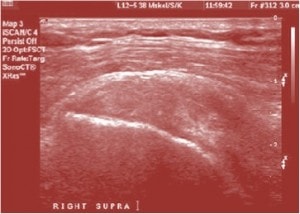If you Ignore a Rotator Cuff Tear: Will its Size Change?
Shoulder rotator cuff tears are common problems of aging, usually caused by less blood supply in the aging rotator cuff and changes in the surrounding tissues that then place pressure on the muscle or tendon. For small tears, the conventional wisdom has been to leave the tear alone and to pursue conservative treatment such as physical therapy, medications, and home exercises. For larger tears, surgery is usually recommended as soon as they’re found. However, a new study suggests that you may want to monitor the tear for awhile before you take some action, as about half will increase in size if left alone and half will stay the same size. The researchers took 51 patients with 61 rotator cuff tears and measured these on MSK ultrasound (orthopedic type ultrasound performed by a skilled doctor in the office). They then went back and looked at the tear size at a mean follow-up of almost 3 years later. At that point, most of the tears (49%) had increased in size, about the same number hadn’t changed (43%), while the minority (8%) had gotten smaller. The tears that did get bigger weren’t found more often in older patients as one might expect and the bigger tears weren’t the ones that got bigger three years later. The single biggest predictive factor for a tear that was getting bigger was that the patient reported significant pain at the time it was first measured. Since the authors measured the size of the tears using ultrasound, this test can be inexpensively accomplished in a doctor’s office (assuming the doctor knows how to use ultrasound). So if you have a tear causing a lot of pain, it may make sense to find a physician skilled in MSK ultrasound to check the tear size once every few months to make sure it’s stable. If it is getting bigger and the tear is not retracted, then non-surgical injection therapy to heal the rotator cuff tear is your next step. If the tear is very large and the ends are retracted like a broken rubber band, then surgery may be indicated to repair the tear.

If you have questions or comments about this blog post, please email us at [email protected]
NOTE: This blog post provides general information to help the reader better understand regenerative medicine, musculoskeletal health, and related subjects. All content provided in this blog, website, or any linked materials, including text, graphics, images, patient profiles, outcomes, and information, are not intended and should not be considered or used as a substitute for medical advice, diagnosis, or treatment. Please always consult with a professional and certified healthcare provider to discuss if a treatment is right for you.

